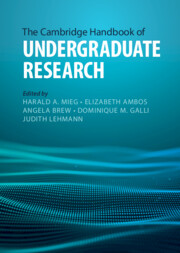Book contents
- The Cambridge Handbook of Undergraduate Research
- The Cambridge Handbook of Undergraduate Research
- Copyright page
- Contents
- Figures
- Tables
- Contributors
- Foreword
- Foreword
- 1 Introduction
- Part I Theory and Research on Undergraduate Research
- Part II Implementation, Approaches, Methods
- Part III Disciplines
- 17 Introduction
- Part III.1 STEM
- Part III.2 Health
- Part III.3 Social Sciences
- Part III.4 Humanities
- Part III.5 Arts & Design
- Part III.6 Disciplines A–Z
- Part IV International Perspective
- Part V Avenues for Developing Undergraduate Research
- Index
17 - Introduction
from Part III - Disciplines
Published online by Cambridge University Press: 11 August 2022
- The Cambridge Handbook of Undergraduate Research
- The Cambridge Handbook of Undergraduate Research
- Copyright page
- Contents
- Figures
- Tables
- Contributors
- Foreword
- Foreword
- 1 Introduction
- Part I Theory and Research on Undergraduate Research
- Part II Implementation, Approaches, Methods
- Part III Disciplines
- 17 Introduction
- Part III.1 STEM
- Part III.2 Health
- Part III.3 Social Sciences
- Part III.4 Humanities
- Part III.5 Arts & Design
- Part III.6 Disciplines A–Z
- Part IV International Perspective
- Part V Avenues for Developing Undergraduate Research
- Index
Summary
Part III comprises views on undergraduate research in a broad disciplinary variety of disciplines. The section is structured within five subject clusters and a list of disciplines that do not match with the clustering. In general, we find examples of undergraduate research in any discipline. In some cases, as in psychology, undergraduate research had always been a (potential) component of the undergraduate curriculum. Therefore, undergraduate research doesn’t look new. In contrast, some university teachers, for instance in mathematics or law, are convinced that their discipline is too complicated to allow for undergraduate research. In the context of our handbook, by far the most common approach to undergraduate research is: just do research. When it comes to the implementation of undergraduate research, best practice arises with pioneering initiatives of engaged teachers or students and often results in organizational solutions, as in changed curricula, new research facilities, or a rethinking of research-based student–staff relationships.
Keywords
- Type
- Chapter
- Information
- The Cambridge Handbook of Undergraduate Research , pp. 185 - 188Publisher: Cambridge University PressPrint publication year: 2022

